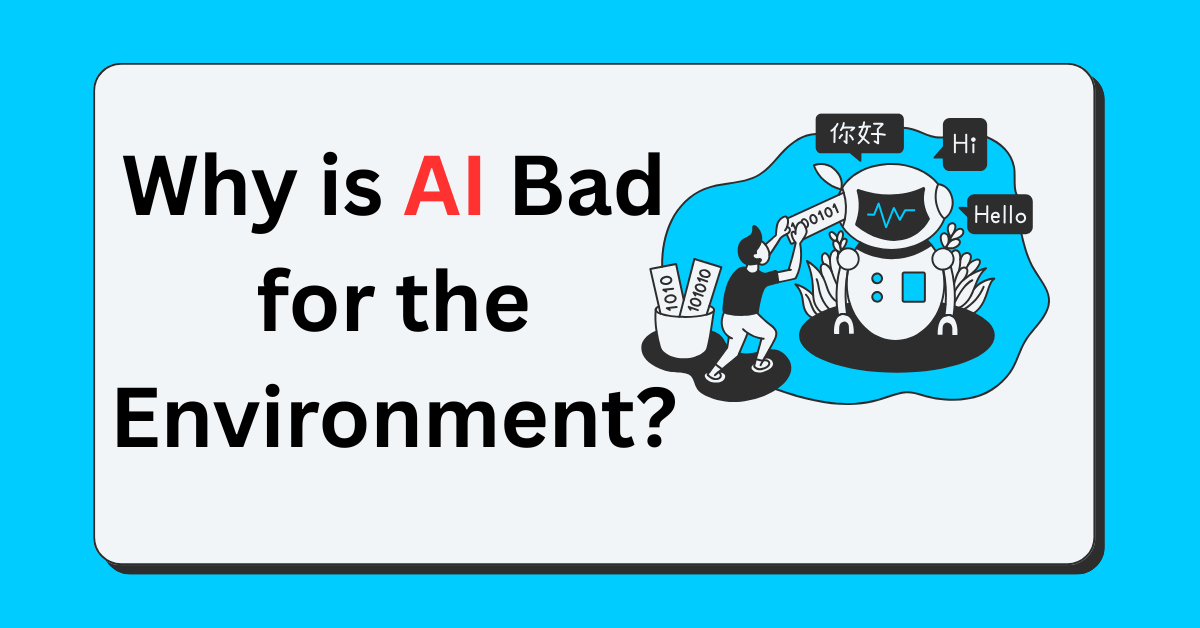In Today’s world, almost all of our activities are held with artificial intelligence. The stuff includes chatbots and indeed self-driving cars; AI makes life easier and faster. But seeing its benefits, we always ignore the hidden costs to Mother Nature. There are massive data centers behind every so-called “intelligent tool”, missing the huge energy needs and massive electronic waste accumulation.
Hence, how bad is AI for the environment? Let us simplify the answers into the major challenges.
Energy Consumption of AI Systems
AI systems are power-hungry. One large AI model will be trained using the same amount of electricity that several houses will consume in a whole year. Naturally, the larger the model, the more energy it would require.

AI runs on very powerful devices such as GPUs and servers. These machines run full throttle, thereby consuming excessive amounts of power. Most of this is still from the fossil fuel sources, which will release a lot of greenhouse gases into the environment.
It is, therefore, through this energy demand that AI becomes a significant contributor to the global warming problem. Should this growth trend continue, the carbon footprint of AI will only get worse for the foreseeable future.
Environmental Impact of Data Centers
As much as AI runs behind huge data centers, these facilities have thousands of servers that process and store information all day long. But unfortunately for the planet, it houses those servers while working for AI.
The data centers heat up and add high carbon emissions. These areas also take up land, consume electricity all day, and increase noise and heat pollution in their vicinity. Some even now report effects from being too close to large data centers.
As AI progresses, so do data centers. Hence, more emissions, more pollution, and more devastation.
E-Waste from AI Infrastructure
AI does not consume energy alone but also generates waste. AI servers, chips, and hardware used in AI have short lives. Every year, new and faster machines get built, and old ones quickly become obsolete.
Most of this old equipment ends up as e-waste. This kind of waste possesses toxic substances such as mercury, cadmium, and lead. If not recycled properly, they can pollute soil and water, harming humans, animals, and plants.
As the technology of AI advances, the pile of electronic waste becomes. Without further improvements in recycling systems, this issue will keep swelling.
Water Usage in AI Cooling Systems
Apart from consuming electricity, AI also requires millions of liters of fresh water to keep its machinery functioning. Fresh water sources are increasingly at the brink of depletion due to the cooling of AI machines. Especially alarming in areas that are already facing water shortages.
Such pressure does affect the local communities and ecosystems, as AI takes its share of the precious water. There has been water usage that is not often mentioned during discussions on AI, yet it forms a pertinent part of the environmental cost.
Climate Change Connection
In the context of these facts, when energy use is put together with high water needs and increased e-waste, artificial intelligence “Matters” into the major driving forces in climate change.
The carbon footprint of AI is increasing very rapidly, and it is going to worsen global warming without green solutions. Although this technology is positive in bringing about innovations, it threatens the planet if it is not managed responsibly.
Resource Extraction for AI Devices
The gadgets driving AI are powered by very few rare minerals like lithium, cobalt, and nickel. The mining of these materials depletes sites and pollutes them. The workers who mine these areas have unsafe conditions too. More mining and deforestation are responsible for huge footprints in terms of human and environmental resources due to chips for powerful AI systems. This makes AI not just a digital issue but also a real-world environmental challenge.
Noise and Heat Pollution
AI data centers produce more than carbon: they produce noise and heat pollution in local areas. While constant machine noise can be disturbing to residents living nearby, excess heat increases local temperatures.
Less-discussed, however, these issues are still affecting, and continue to be, the quality of life around the data centers.
Can AI become Greener?
The upside is that viable solutions do exist. Some things could be done by technological organizations and governments to make AI more sustainable. Among others, the following ideas are put forth:
- Switch to renewable energy for data centers.
- Use smarter cooling systems that waste less water.
- Recycle old hardware to reduce e-waste.
- Design energy-efficient AI models that need less training power.
- Set global rules for sustainable AI growth.
- Use AI itself to help solve environmental and sustainability challenges
Change is likely to be difficult. Change is, however, necessary. If industries cooperate, then AI can be grown without polluting the earth as much.
FAQs
1. How does AI negatively affect the environment?
It hurt the environment through very high energy usage, carbon emissions, production of e-waste, and a very high consumption of water for cooling the data centers, which affects the resources and only contributes to pollution across the world.
2. How bad is ChatGPT actually for the environment?
ChatGPT consumes significant electricity through constant server operations and cooling needs. Handling millions of queries daily creates a large carbon footprint, contributing to energy demand and environmental stress.
3. What are three reasons AI is bad?
- High energy consumption from training and running large AI systems.
- Frequent hardware upgrades and outdated equipment cause E-waste pollution.
- Water usage in cooling systems strains local water supplies in many regions.
Conclusion
So why is AI bad for the environment? In short, energy consumption, environmental degradation of data centers, e-waste generated by AI infrastructures, and water consumption in AI cooling systems have become the four most salient factors contributing to climate change. Together, they create a highly negative carbon footprint.
AI is not evil. But the sun-green influence cost is too high. The future of AI requires the creation of better systems, but also cleaner and greener methods of operation. Only when this occurs can we derive the advantages of AI without the destruction of the planet we inhabit.
REFERENCE:
https://link.springer.com/chapter/10.1007/978-981-96-6863-2_7








When someone writes an pst he/she keeps the plan of a user in his/her brain that how a user can be aware
of it. Thus that’s whyy this paragraph is perfect.
Thanks!